From Lychees Online
by Krystal Folino and Bill Mee
'Mauritius'
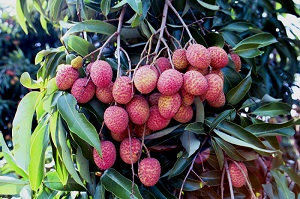
Fig. 1 
'Mauritius' lychee cluster
The second most common commercially produced lychee in South Florida is
the 'Mauritius' variety.
'Mauritius'
fruit typically ripens several weeks earlier than the 'Brewster' and is
easily distinguished from it's counterpart by the pinkish green skin
coloration (Fig. 2a, 2b) characteristic of ripe fruit.
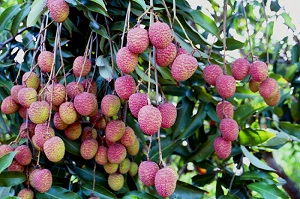
|
 |
Fig. 2a 
Close-up 'Mauritius' cluster |
Fig. 2b 
Close-up of ripe 'Brewster' lychees |
The flavor of 'Mauritius' fruit is distinctly different and spicier
than the 'Brewster' and is quite delicious.
Another
favorable characteristic of the 'Mauritius' is the higher percentage of
small ("chicken tongue") seeds within a given batch of fruit, although
the 'Mauritius' lychee tends to be smaller than the 'Brewster'.
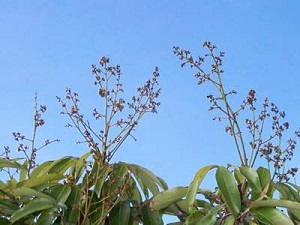 |
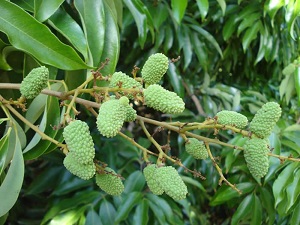 |
Fig. 3 
Early flower panicle |
Fig. 4 
'Mauritius' fruits almost one month from maturity |
'Mauritius' fruit should begin to ripen around the middle to the end of
May.
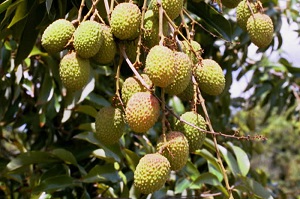 |

|
Fig. 5a 
Up close look at ripening 'Mauritius' fruit |
Fig. 5b 
'Mauritius' clusters turning pink |
This
close-up photo (Fig. 5a) of 'Mauritius' fruit shows how the fruit turns
pink or red as it ripens. The bumps on the skin of the fruit and the
area around where the stem and the top of the fruit meet turns red
first. In Fig. 5b, this 'Mauritius' fruit is ripening nicely and should
be ready to pick in about 2 weeks. The tops of most of the lychees is
starting to turn pink and then red.
The sub-acid sweet aril of
ripe 'Mauritius' fruit is slightly tart and as the fruit ages on the
tree the flesh becomes firmer and less juicy.
Overripe 'Mauritius'
fruit develop a noticeable membrane around the flesh and the skin of
the fruit frequently gets fungal discoloration.
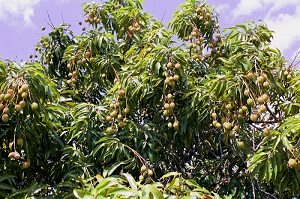
Fig. 6 
Looking up at a lychee treetop loaded with fruit
This
photo is looking up at the canopy of a 'Mauritius' lychee tree loaded
with ripening fruit. The best fruit on the is at the top of lychee tree
where it gets the most sun. Most of the fruit shown in this photo are
turning pink, but some are still green.You can really see how the fruit
does not ripen uniformly on the tree.
Once you have developed a familiarity with lychee trees it is fairly
easy to distinguish a 'Mauritius' from a 'Brewster' and
a 'Hak Ip'.
The 'Mauritius' has a somewhat lateral habit of growth whereas the
'Brewster' develops a hemispherical shape as it ages.
Wildlife
is always a problem around fruit groves and lychee fruit are enjoyed by
a wide variety of native animals. This wouldn't be so bad except that
'Mauritius' trees have branches that are significantly weaker than
'Brewster' and an attack by foraging raccoons can leave a mass of
broken branches. High winds, such as hurricanes, can inflict
considerable damage on Mauritius trees.
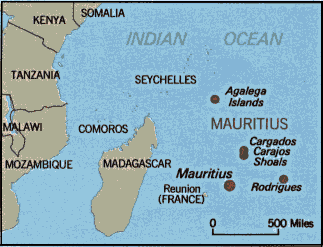
The
Mauritius variety of lychee was named after the African island of
Mauritius, east of Madagascar, where the seedling originated.
by Bill Mee and Krystal Folino - Lychees Online
Back to
Lychee Page
|
|
Bibliography
Folino, Krystal and Bill Mee. "Mauritius Variety/Cultivar of
Lychee." lycheesonline.com.
Updated Jan. 10 2004. Web. 25 Jan. 2014.
Photographs
Fig. 1,2a,2b3a,3b,4,5a,5b,6 Folino, Krystal and Bill Mee. MauritiusVariety/Cultivar
of Lychee. N.d. lycheesonline.com. Web. 4 June 2014.
Fig. 3 Maguire, Ian. Early Flower Panicle.
N.d. Tropical Fruit Photography Picture Archive. trec.ifas.ufl.edu.
Web. 3 June 2014.
Published 25 Jan. 2014 LR. Last update 4 June 2014 LR
|









